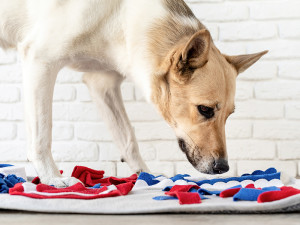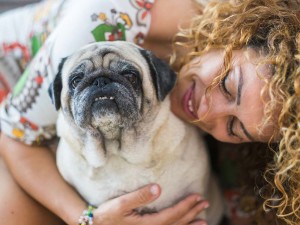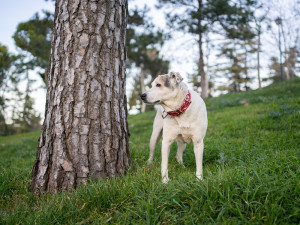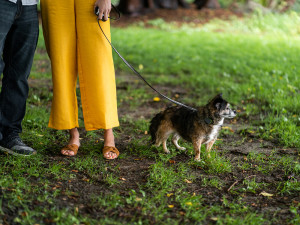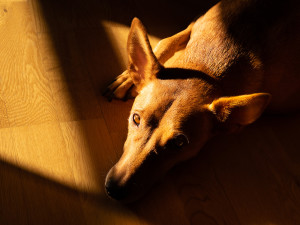Help! My Senior Dog Is Bored!
Physical exercise isn’t the only way to stimulate your dog—engaging their mind works, too.

share article

Your pet wants you to read our newsletter. (Then give them a treat.)
My 12-year-old Bulgarian Shepherd, Gus, has never been very interested in play. He struggles to play with other dogs and is not interested in fetch, tug or chase with me. He loves long walks and going to the dog park, but now that he’s older and has arthritis, my vet has directed me to keep our walks and visits to the dog park (disappointingly) short. Gus has been very restless. How do I get my quirky boy to play with me and work off some of this energy?
Your instincts are spot on when you suggest that he may be seeking more activity. Many dogs exhibit restless behavior when they’re looking for things to do, but more exercise isn’t the only answer to this dilemma.
There are a lot of ways to keep a dog active and busy other than play, long walks or going to the dog park. The goal is to keep his mind engaged so he doesn’t become bored. Given Gus’s lack of interest in play and the physical limitations imposed by your vet because of his arthritis, now is the perfect time to explore some new ways to keep him busy.
Bring out the food puzzles.
One of the easiest ways to give your dog some mental stimulation is to feed him via food puzzles rather than putting his meal in a bowl. Dogs usually enjoy working for their food as long as they have success at it. In other words, don’t make it so hard that Gus can’t get his food—just hard enough that it’s a fun challenge.
All kinds of options exist for feeding dogs in a way that engages their brains. You can stuff Kongs and even freeze them to make them last longer, put kibble or treats in a snuffle matopens in a new tab, or use a food puzzle toyopens in a new tab designed to release treats as the dog pushes or tosses the toy around. You can use wooden, rubber or plastic toys, but do supervise, especially when presenting him with a new toy, to make sure he is using it safely. If Gus can handle ice cubes without harm to his teeth or risk of choking, freeze treats in ice cubes and offer them to him.
Or, try placing bits of food in separate compartments of something like an egg carton or a muffin tin. Make sure each compartment has its own little puzzle, such as a piece of food wrapped in a paper towel, a similarly-sized piece of fabric or inside toilet-paper rolls folded over on the ends. And again, watch to make sure Gus doesn’t eat anything that’s not meant to be ingested. Don’t use any non-edible items he is likely to eat. You can wrap treats in lettuce leaves or other vegetables if he can eat those. Some dogs treat vegetables like puzzles and work to get the treats inside and others just swallow the whole thing.
Make a treasure trail.
Make Gus a scent trail by dragging something smelly along the floor, or scatter pieces of kibble with treats mixed in. The trail itself is fun for dogs, but you can also have the trail lead Gus to a discovery, such as something to chew on, a new toy or a larger pile of treats.
Do training for fun.
Training has a purpose—to teach your dog—but just because it has practical benefits doesn’t mean that it can’t be fun, too. In fact, even though dogs need to learn leash manners and various cues (such as sit, down, stay, leave it, wait, come and so forthopens in a new tab), I primarily think of training as a great way to spend quality time together. The advantages of training go way beyond the skills your dog actually learns.
Done properly—using positive reinforcement and allowing the dog to consistently succeed—training’s benefits are endless. Opportunities to be right, to figure things out, to try new things and to get a lot of mental exercise are so good for dogs. Many dogs love learning tricksopens in a new tab in addition to more general skills, in part because owners are generally more relaxed when working on tricks; tricks also allow dogs to show off to other people and get attention for performing them.
Training enables people and dogs to interact and to “win” together. Practical, fun and great for the relationship? That’s what training offers, and it doesn’t get any better than that.
Games around the house.
A couple of games you can play in the house are often appealing even to dogs who are not super-easy to engage in play in the classic ways (chase, tug, fetch). One is called “Find Your Treat.” To play, ask your dog to stay while you hide treats in another room (if his stay isn’t solid, put him behind a closed door). Then, release him to search for the treats. When he gets good at the game, you can hide the treats in tricky spots and keep him occupied for quite some time.
Another search game is “Hide-and-Seekopens in a new tab,” which starts in a similar way, asking your dog to stay in a specific spot. Then, you hide, release him from his stay and call him to come. Reinforce him with treats and attention when he discovers you.
Chew toys are a good pick.
Giving dogs things to chew onopens in a new tab is a great way to keep them happily occupied for a long time. Whether or not Gus has a history of chewing for fun, I’d explore this option. Some dogs don’t get into recreational chewing until they’ve been offered a smorgasbord of options—the only way to tell if he really has no interest or if you just haven’t discovered a chew toy that appeals to him.
Bully sticks, Nylabones, Greenies, cow hooves, Himalayan yak chews and antlers are possibilities. There are a lot of opinions about which chew toys are safe for dogs, with rawhide being almost universally rejected and real bones igniting controversy. Check with your vet to determine what’s safe for Gus.
Massage your pup.
Your undivided attention is the most likely way to occupy Gus and make him the happiest. In these pandemic times, many dogs are struggling with having us home so much but working (i.e., not giving them all of our attention). Scheduling breaks during the day during which we truly focus on our dogs without distractions helps tame their restlessness and be better able to settle down and chill as we work.
A petting or massage sessionopens in a new tab is a perfect way to attend to our dogs, especially older dogs, who may be more likely to have some stiff or sore spots. The physical contact and emotional connection generated by this type of activity can benefit both of you.
Reframe the issue you are having with Gus. Think of him as a dog who needs more activities in his life rather than a dog who needs more exercise or play in his life. You certainly don’t have to do everything. Pick a few something that appeals to you, or experiment to see what captures Gus’s interest and helps dial back his restlessness and tendency to disturb you while you’re working.

Karen B. London, PhD, CAAB, CPDT-KA
Karen B. London, Ph.D., is a Certified Applied Animal Behaviorist and Certified Professional Dog Trainer who specializes in working with dogs with serious behavioral issues, including aggression, and has also trained other animals including cats, birds, snakes, and insects. She writes the animal column for the Arizona Daily Sun and is an Adjunct Professor in the Department of Biological Sciences at Northern Arizona University. She is the author of six books about training and behavior, including her most recent, Treat Everyone Like a Dog: How a Dog Trainer’s World View Can Improve Your Lifeopens in a new tab.
Related articles
![Curly haired blonde woman hugging her old pug dog]() opens in a new tab
opens in a new tabHow to Care For Your Older Dog
Learn how to make their senior years as comfortable as possible.
![A senior white dog with arthritis wearing a red collar standing by a large tree in the grass outside]() opens in a new tab
opens in a new tabMedication For Dog Arthritis: Dog Arthritis Pain Management
Hope for dogs with arthritis is on the horizon.
![Woman in yellow wide leg pants standing next to a man with jeans holding the leash of their small adult dog in a grassy area]() opens in a new tab
opens in a new tab“Help, My Adult Dog Refuses to Pee Outside”
The Wildest Collective dog trainer Robert Haussmann’s tips for helping an adult dog learn to go outside in a new environment.
![Dog lying on the wood floor is bathed in the sunset light]() opens in a new tab
opens in a new tabWhen Your Dog Gets Alzheimer’s
For dogs with Alzheimer’s, confusion may reign as light falls.
